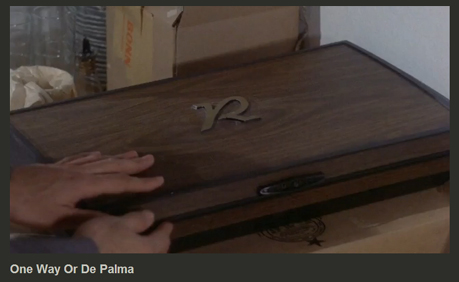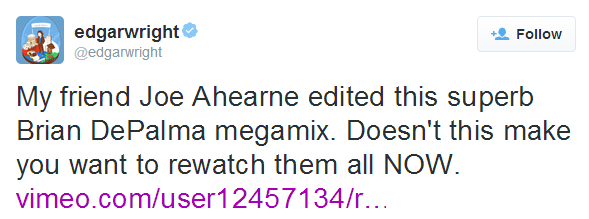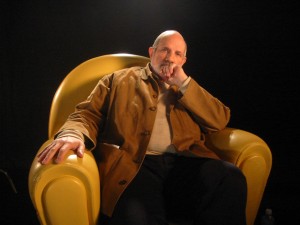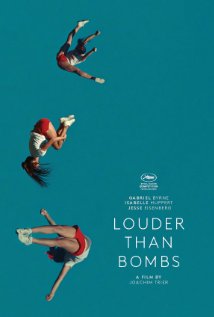
 Hello and welcome to the unofficial Brian De Palma website. Here is the latest news: |
|---|
E-mail
Geoffsongs@aol.com
-------------
Recent Headlines
a la Mod:
Listen to
Donaggio's full score
for Domino online
De Palma/Lehman
rapport at work
in Snakes
De Palma/Lehman
next novel is Terry
De Palma developing
Catch And Kill,
"a horror movie
based on real things
that have happened
in the news"
Supercut video
of De Palma's films
edited by Carl Rodrigue
Washington Post
review of Keesey book
-------------
Exclusive Passion
Interviews:
Brian De Palma
Karoline Herfurth
Leila Rozario
------------
------------
| « | September 2015 | » | ||||
| S | M | T | W | T | F | S |
| 1 | 2 | 3 | 4 | 5 | ||
| 6 | 7 | 8 | 9 | 10 | 11 | 12 |
| 13 | 14 | 15 | 16 | 17 | 18 | 19 |
| 20 | 21 | 22 | 23 | 24 | 25 | 26 |
| 27 | 28 | 29 | 30 | |||
De Palma interviewed
in Paris 2002
De Palma discusses
The Black Dahlia 2006

Enthusiasms...
Alfred Hitchcock
The Master Of Suspense
Sergio Leone
and the Infield
Fly Rule
The Filmmaker Who
Came In From The Cold
Jim Emerson on
Greetings & Hi, Mom!
Scarface: Make Way
For The Bad Guy
Deborah Shelton
Official Web Site
Welcome to the
Offices of Death Records


One Way Or De Palma from Joe Ahearne on Vimeo.
Rob Dean at A.V. Club asked Joe Ahearne about the creation of the excellent video he posted on Vimeo recently, One Way Or De Palma, in which he masterfully edited images from the films of Brian De Palma, setting them to a soundtrack of Blondie's One Way Or Another. Here is what Ahearne had to say to Dean:
I saw my first De Palma film when I was 17—Dressed To Kill—and that film taught me what it was a director does. It was only on repeated viewings that I realised what was happening with the slow motion (so gripped was I, I didn’t even realise the film had slowed down), the music, the colour, the editing, the framing, the camera moves, the story-telling (later on of course I realised what a superb director of actors he was too). And I hunted down all his films before and since (almost—haven’t seen Get To Know Your Rabbit yet!). I grew up on spectacle like Star Wars but De Palma showed me how a director could invest human scale drama with even more extraordinary emotion and intensity. Anyone who’s seen any of the stuff I’ve done who loves De Palma will easily spot the influences.For a long time I’ve wanted to use De Palma’s images against Blondie’s “One Way or Another.” They share a certain obsessive quality. It was so great viewing De Palma’s last 22 films and appreciating him like a great composer, enjoying the reworking and recapitulation and reframing of themes - hearing his voice, I suppose. What really came home to me this time (I’ve seen them all many times) was what a master of colour he is. I tried to reflect that in the cut.
 Joe Ahearne, the writer/director whose Trance was recently made into an excellent feature film directed by Danny Boyle, edited together an amazing supercut of shots from Brian De Palma films set to Blondie's One Way Or Another. Titled One Way Or De Palma, the video was put together with great revelatory skill by someone who obviously knows these movies very well. This has to be the best "megamix" of De Palma's films I've seen yet-- it's a stunner, done with superb care and wit. Below is the tweet from Edgar Wright that brought my attention to the video (I cannot embed the video, so you'll have to watch it on Vimeo, where you can also download it).
Joe Ahearne, the writer/director whose Trance was recently made into an excellent feature film directed by Danny Boyle, edited together an amazing supercut of shots from Brian De Palma films set to Blondie's One Way Or Another. Titled One Way Or De Palma, the video was put together with great revelatory skill by someone who obviously knows these movies very well. This has to be the best "megamix" of De Palma's films I've seen yet-- it's a stunner, done with superb care and wit. Below is the tweet from Edgar Wright that brought my attention to the video (I cannot embed the video, so you'll have to watch it on Vimeo, where you can also download it).
 Italian TV channel Studio Universal will present a tribute to Brian De Palma to mark his 75th birthday on September 11, 2015, according to TV Numeriuno. The Cinechat, which has already been recorded (with De Palma sitting in the yellow chair seen here), will be followed by a showing of De Palma's Casualties Of War. The TV Numeriuno article/press release includes several quotes from De Palma, pulled from the Cinechat:
Italian TV channel Studio Universal will present a tribute to Brian De Palma to mark his 75th birthday on September 11, 2015, according to TV Numeriuno. The Cinechat, which has already been recorded (with De Palma sitting in the yellow chair seen here), will be followed by a showing of De Palma's Casualties Of War. The TV Numeriuno article/press release includes several quotes from De Palma, pulled from the Cinechat:"When I returned to Italy I was in college. I arrived in Rome with two friends and I bought a Lambretta. I will never forget the tours I made by Vittorio Emanuele... then I took a car and drove from Venice all the way to Paris. During the trip I saw the beautiful cities of Siena, Perugia, Florence with a sensation of how much beauty there is in this country."
"My experiences and my feelings are part of my films and the Italian cinema affected me very much. I remember Rossellini, Anna Magnani, and also the way in which Antonioni visually conceptualized his ideas. I will never forget movies like L’Avventura or Red Desert."
"In my opinion the best American film about Italy is The Godfather, and not because we talk about mafia, but because it tells us that the family is an integral part of Italian culture."
 This past June, I posted a link with an excerpt from a Cannes interview with Joachim Trier, in which the director talked about writing and creating a diary section (a kind of movie within the movie) of his new film Louder Than Bombs. In that interview, Trier told The Upcoming's Christian Herschmann that prior to discovering the social realist films of Ken Loach, Steven Frears, and Mike Leigh, "I was really into Antonioni, Alain Resnais and Brian De Palma. I wanted montage and the break of the image and the form to be really at the essence of what I did, and I think I changed."
This past June, I posted a link with an excerpt from a Cannes interview with Joachim Trier, in which the director talked about writing and creating a diary section (a kind of movie within the movie) of his new film Louder Than Bombs. In that interview, Trier told The Upcoming's Christian Herschmann that prior to discovering the social realist films of Ken Loach, Steven Frears, and Mike Leigh, "I was really into Antonioni, Alain Resnais and Brian De Palma. I wanted montage and the break of the image and the form to be really at the essence of what I did, and I think I changed."In a new interview posted yesterday by Variety's Jon Asp (from the Norwegian Film Festival at Haugesund), Trier is asked how he comes up with ideas. "I like working intuitively," Trier responds, "in what I call dirty formalism, or pop formalism. I jokingly say that our films should be like great albums with different songs. I am a big fan of Nicolas Roeg, Don’t Look Now, which could be very specific conceptual things, but it was a warm formalism, it didn’t alienate you. I’m also a very big fan of Brian De Palma. I believe in the idea of doing a cinematic set piece, like Conrad’s diary, it’s like film in itself, or the car crash sequence with Isabelle, and the association of the son thinking of his mother and the last moments of her death, are whole set pieces, a film within the film. So it’s like an album. You have different songs, hopefully most of them are hits."

 The New York Film Festival announced today that Noah Baumbach and Jake Paltrow's De Palma documentary will have its North American premiere at this year's fest as part of its Special Events lineup. In conjunction with that screening, De Palma's Blow Out will screen at the festival under its Revivals section. Both films will screen on Wednesday, September 30th (De Palma at 5pm and Blow Out at 8pm). The NYFF runs September 25 through October 11. Below are the festival's descriptions of both films:
The New York Film Festival announced today that Noah Baumbach and Jake Paltrow's De Palma documentary will have its North American premiere at this year's fest as part of its Special Events lineup. In conjunction with that screening, De Palma's Blow Out will screen at the festival under its Revivals section. Both films will screen on Wednesday, September 30th (De Palma at 5pm and Blow Out at 8pm). The NYFF runs September 25 through October 11. Below are the festival's descriptions of both films:De Palma
Noah Baumbach & Jake Paltrow, USA, 2015, DCP, 107m
Noah Baumbach and Jake Paltrow’s fleet and bountiful portrait covers the career of the number one iconoclast of American cinema, the man who gave us Carrie, Dressed to Kill, Blow Out, and Carlito’s Way. Their film moves at the speed of De Palma’s thought (and sometimes works in subtle, witty counterpoint) as he goes title by title, covering his life from science nerd to New Hollywood bad boy to grand old man, and describes his ever-shifting position in this thing we call the movie business. Deceptively simple, De Palma is finally many things at once. It is a film about the craft of filmmaking—how it’s practiced and how it can be so easily distorted and debased. It’s an insightful and often hilarious tour through American moviemaking from the 1960s to the present, and a primer on how movies are made and unmade. And it’s a surprising, lively, and unexpectedly moving portrait of a great, irascible, unapologetic, and uncompromising New York artist. In conjunction with this film, we will also be showing De Palma’s masterpiece Blow Out. North American PremiereBlow Out
Brian De Palma, USA, 1981, 35mm, 107m
One of Brian De Palma’s greatest films and one of the great American films of the 1980s, Blow Out is such a hallucinatory, emotionally and visually commanding experience that the term “thriller” seems insufficient. De Palma takes a variety of elements—the Kennedy assassination; Chappaquiddick; Antonioni’s Blow-Up; the slasher genre that was then in full flower; elements of Detective Bob Leuci’s experiences working undercover for the Knapp Commission; the harshness and sadness of American life; and, as ever, Hitchcock’s Vertigo—and swirls and mixes them into a film that builds to a truly shattering conclusion. With John Travolta, in what is undoubtedly his greatest performance, as the sound man for low-budget movies who accidentally records a murder; Nancy Allen, absolutely heartbreaking, as the girl caught in the middle; John Lithgow as the hired killer; and De Palma stalwart Dennis Franz as the world’s biggest sleaze. This was the second of three collaborations between De Palma and the master DP Vilmos Zsigmond. MGM Home Entertainment.